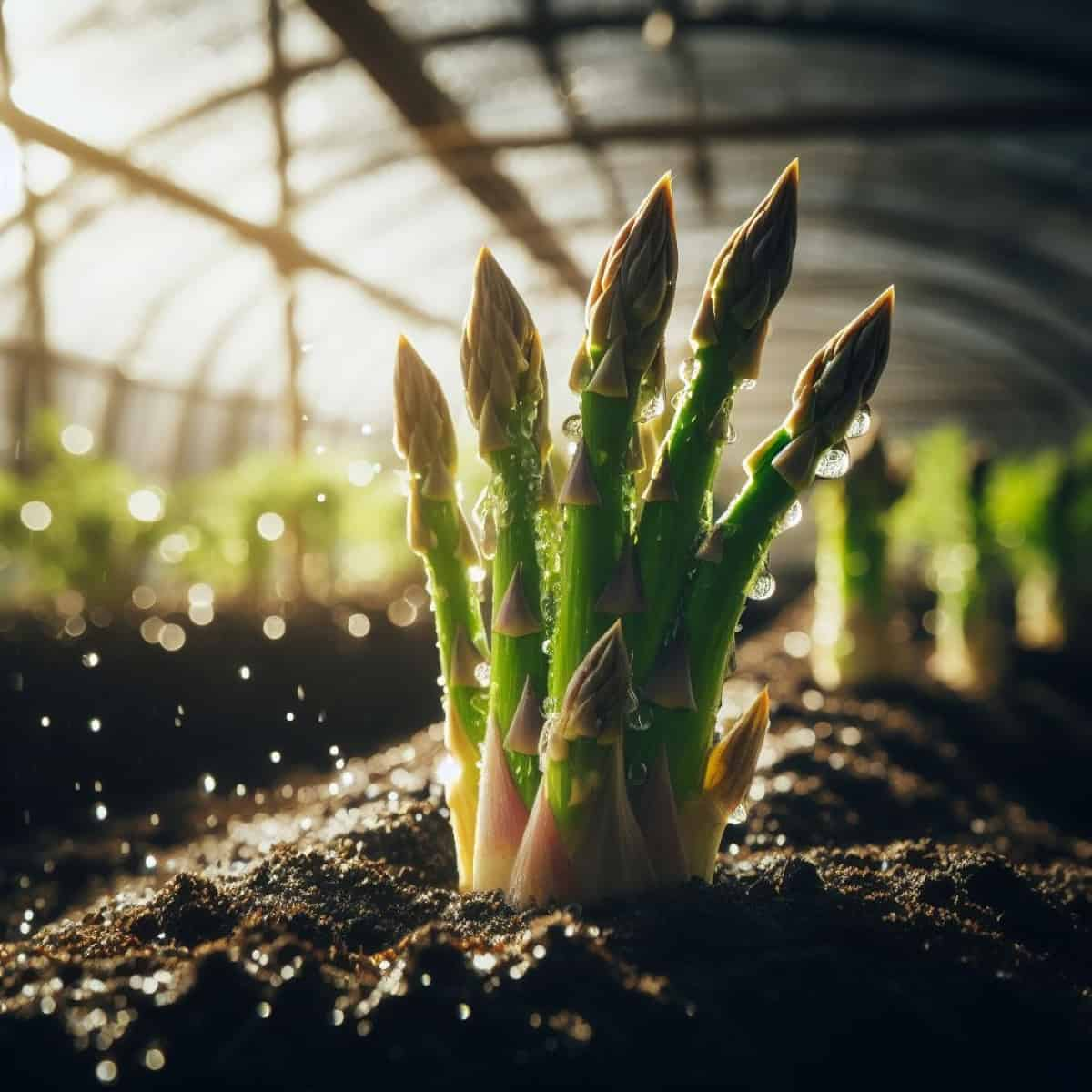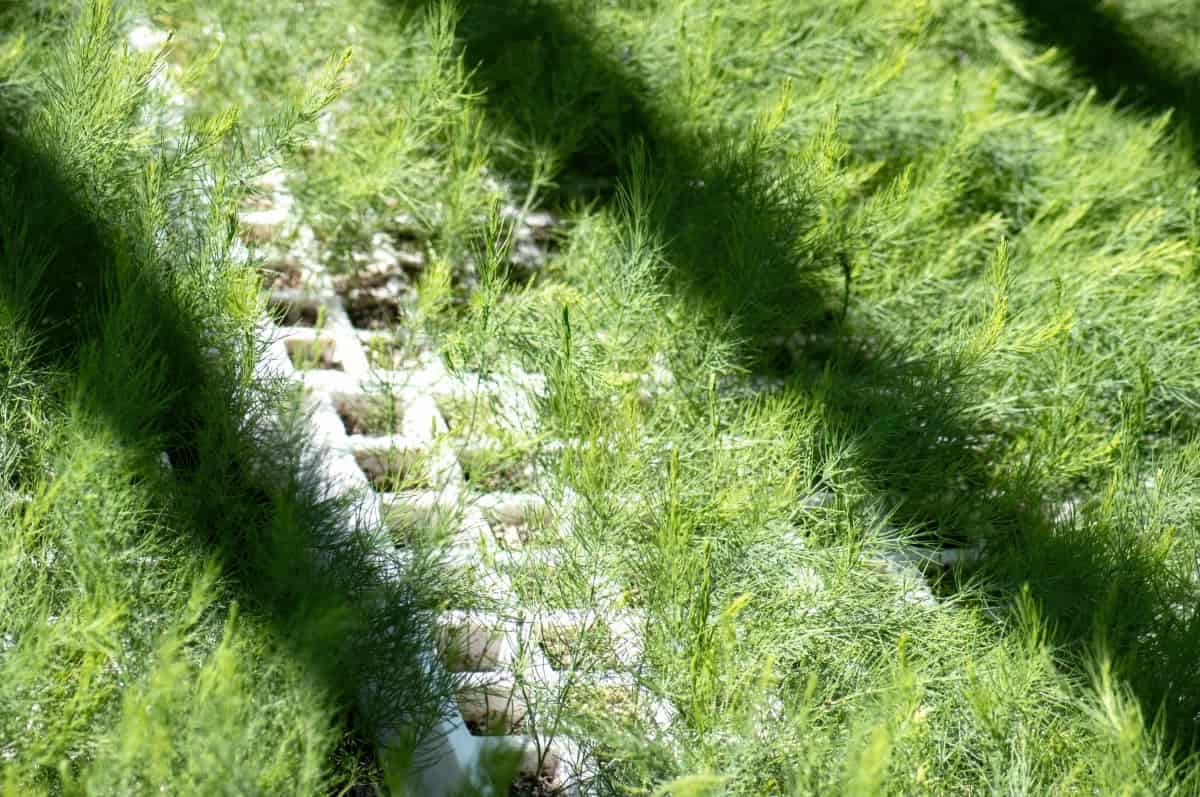Growing asparagus in greenhouses is an excellent way for beginners to extend their gardening season and enjoy fresh produce year-round. This guide will cover the essential steps and considerations for cultivating asparagus indoors, particularly focusing on greenhouse conditions, suitable asparagus types, soil preparation, planting techniques, irrigation, fertilization, and pest management. Whether you’re looking to grow asparagus in a greenhouse during winter or from seed, this guide will provide you with the knowledge you need to succeed.

How to Grow Asparagus in Greenhouses
Ideal Growing Conditions for Asparagus in Greenhouses
Creating the ideal growing conditions for asparagus in your greenhouse is crucial. Asparagus thrives in a controlled environment where temperature and humidity can be maintained consistently. The optimal temperature conditions for asparagus cultivation are a daytime range of 70-85°F and nighttime temperatures between 60-70°F. High humidity levels, around 70-80%, are also essential for healthy growth.
Good ventilation in the greenhouse is necessary to prevent the buildup of excessive humidity and to maintain air circulation, which helps in preventing fungal diseases. Adequate sunlight is vital, so ensure your greenhouse allows for at least 6-8 hours of direct sunlight daily. If natural light is insufficient, especially in winter, consider supplementing with grow lights to provide the necessary light spectrum for the asparagus plants to develop properly.
Right Asparagus Types for Your Greenhouse Farming
Choosing the right type of asparagus for your greenhouse is important. There are several varieties suitable for greenhouse cultivation, each with its own growth habits and flavor profiles. Some popular choices include Jersey Knight, Mary Washington, and Purple Passion. These varieties are known for their robust growth and high yield in greenhouse conditions.
When selecting asparagus varieties, consider factors like your local climate, the size of your greenhouse, and your taste preferences. Some varieties may be more tolerant to colder temperatures, making them ideal for growing asparagus in a greenhouse during winter.
Getting Your Soil Ready for Asparagus in Greenhouses
Soil preparation is a key step in successful asparagus cultivation in greenhouses. Asparagus prefers well-drained, nutrient-rich soil with a pH level between 6.5 and 7.5. Before planting, test your soil’s pH and amend it if necessary. Using natural materials like compost or matured manure improves soil quality and fertility.
In case you missed it: Integrated Pest Management in Asparagus Farming: IPM Strategies for Sustainable Asparagus Cultivation

Ensure the soil is loose and well-aerated to facilitate root growth and water drainage. Raised beds can be an effective solution in greenhouses, as they provide excellent drainage and make it easier to control soil conditions. Regularly check the soil moisture and avoid waterlogging, as asparagus does not tolerate standing water.
How to Plant and Space Asparagus in Greenhouses
Planting and spacing asparagus correctly in your greenhouse is essential for optimal growth. Start by planting asparagus crowns or seeds. If using crowns, plant them about 6-8 inches deep and 12-18 inches apart in rows that are 3-4 feet apart. When growing asparagus from seed, start the seeds indoors in small pots or trays before transplanting them into the greenhouse once they are strong enough. Transplant the seedlings at a similar depth and spacing as the crowns.
Effective Irrigation and Watering Practices for Greenhouse Asparagus
Watering asparagus in a greenhouse requires a balance to ensure the plants receive enough moisture without becoming waterlogged. Asparagus plants have deep roots and are relatively drought-tolerant once established, but they still need consistent moisture, especially during the growing season. Implement a regular watering schedule, ensuring the soil is moist but not saturated. Drip irrigation systems can be highly effective in greenhouses, providing consistent moisture directly to the roots while minimizing water wastage and reducing the risk of foliar diseases.
Fertilization Strategies for Greenhouse Asparagus
Fertilizing your asparagus plants properly is key to promoting healthy growth and high yields. Asparagus benefits from a balanced fertilizer that provides a mix of nitrogen, phosphorus, and potassium. Apply a general-purpose fertilizer at the beginning of the growing season to encourage strong shoot development.
During the growing season, additional side-dressings of compost or well-rotted manure can provide extra nutrients and improve soil health. Exercise caution to avoid excessive fertilization, as an abundance of nitrogen can result in the development of frail and thin plant shoots. Regularly test your soil to monitor nutrient levels and adjust your fertilization strategy accordingly.
Managing Pests and Diseases in Greenhouse Asparagus Cultivation
Finally, managing pests and diseases is critical for maintaining a healthy asparagus crop in a greenhouse. Common pests like asparagus beetles and aphids can be controlled through regular inspection and prompt action. Utilize natural pest control solutions such as neem oil or insecticidal soap for addressing infestations. Diseases such as rust and fusarium wilt can be prevented by maintaining good air circulation, proper spacing, and sanitation practices. Remove any infected plants promptly to prevent the spread of disease.
In case you missed it: How to Manage Pests, Diseases, and Weeds in Asparagus Farming

Pruning and Maintenance of Asparagus Plants in Greenhouses
Pruning and regular maintenance are vital for the health and productivity of asparagus plants in greenhouses. Start by eliminating any unhealthy or injured leaves that could attract pests or diseases. Throughout the growing season, prioritize maintaining a well-kept and orderly greenhouse. Routinely check plants for signs of stress or damage, and trim them as needed to encourage proper airflow and light access.
Following the harvest season, permit the ferns to grow as they play a vital role in photosynthesis, enabling the plant to store energy for the upcoming growing season. Cut back the ferns only after they have turned yellow or brown in the fall. This annual pruning helps to rejuvenate the plants and ensures vigorous growth in the following season.
Harvesting and Post-Harvest Handling of Greenhouse-Grown Asparagus
Harvesting asparagus at the right time is crucial for ensuring the best flavor and quality. Asparagus spears are typically ready to harvest when they are about 6-10 inches tall, and the tips are still tight. Use a sharp knife to cut the spears at ground level, being careful not to damage the crown.
After harvesting, wash the spears gently and cool them as soon as possible to maintain freshness. Proper post-harvest handling is important; store the asparagus spears in a cool, humid environment to preserve their quality. If stored properly, asparagus can last for several weeks, making it a great crop for extended marketing opportunities.
How to Extend the Growing Season for Asparagus in Greenhouse Environments
Extending the growing season for asparagus in greenhouse environments involves manipulating the greenhouse conditions to mimic the plant’s natural growing cycle. Utilize heating systems to maintain optimal temperatures during colder months, allowing you to start the growing season earlier or extend it later into the year.
In case you missed it: Caring for Young Asparagus Plants: Watering, Fertilizing, and Mulching

Supplemental lighting can also be used to provide additional daylight hours, encouraging growth when natural light is limited. By managing the greenhouse environment, you can efficiently lengthen the asparagus growing season, enabling multiple harvests and an extended supply of fresh produce.
Conclusion
Growing asparagus in greenhouses is a rewarding endeavor that allows gardeners to enjoy this nutritious vegetable almost year-round. By understanding and implementing the right techniques for planting, maintenance, irrigation, fertilization, and pest control, you can achieve a bountiful harvest of asparagus.
- Feed Your Flock for Less: Top 10 Tips to Save on Chicken Feed
- Ultimate Guide to Ossabaw Island Hog: Breeding, Raising, Diet, and Care
- Hatching Answers: The Top 10 Reasons Your Chickens Aren’t Laying Eggs
- Eggs and Economics: Breaking Down the Cost of Raising Backyard Chickens
- Defend Your Greens: Proven Methods to Keep Iguanas Out of Your Garden
- Ultimate Guide to Cinnamon Queen Chicken: A Comprehensive Guide for Beginners
- Ultimate Guide to California Tan Chicken: Breeding, Raising, Diet, Egg-Production and Care
- Ultimate Guide to Marsh Daisy Chicken: Breeding, Raising, Diet, and Care
- 10 Types of Chicken Farming Businesses You Can Start for Profits